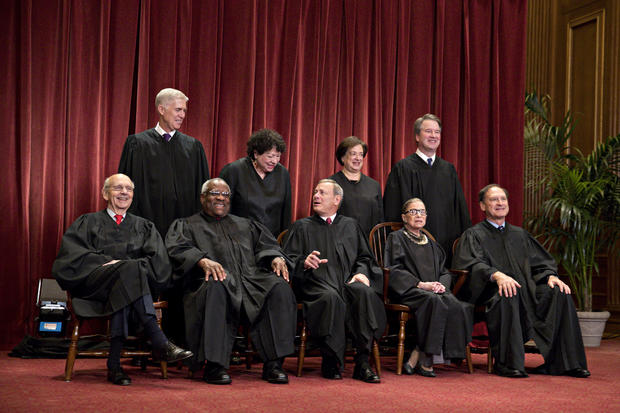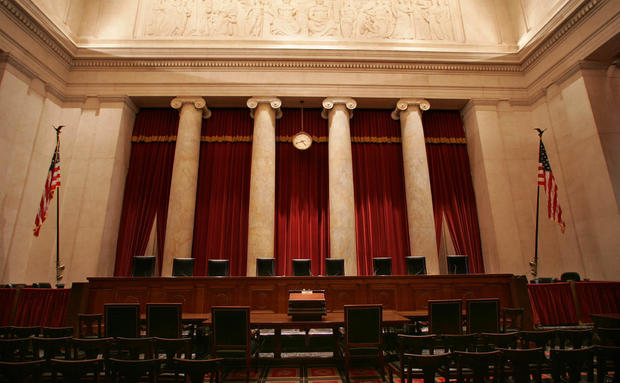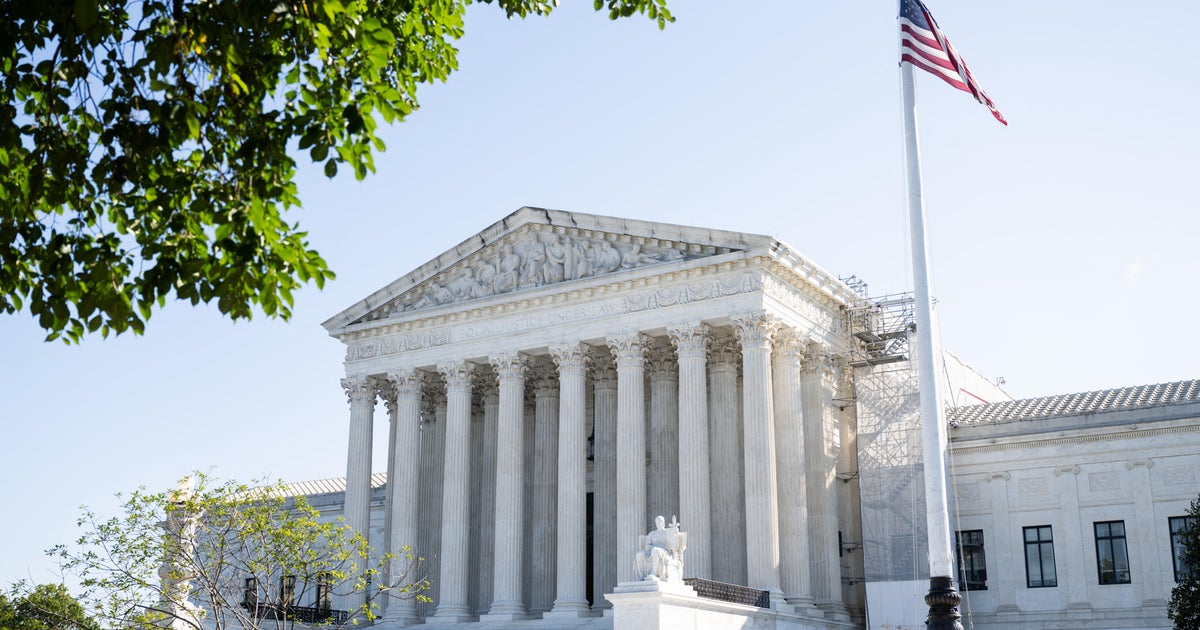Is the Supreme Court too partisan? Here’s what 3 reform proposals would do

Watch the CBS Reports documentary “Does the Supreme Court Need Reform?” in the video player above.
President Biden is forming a bipartisan commission to study potential options for expanding or reforming the U.S. Supreme Court, an issue he pledged to consider during the 2020 presidential campaign. The commission of constitutional scholars, former judges and other experts has six months to file a report on their findings.
The idea of overhauling the makeup of the high court gained traction among progressives after the contentious and partisan confirmation fights over Justices Neil Gorsuch in 2017 and Brett Kavanaugh a year later, and especially after Republicans pushed through the nomination of Amy Coney Barrett to replace Justice Ruth Bader Ginsburg right before the 2020 election — solidifying a 6-3 conservative majority.
According to a 2019 Quinnipiac University poll, 51% of American voters believe the Supreme Court “should be restructured in order to reduce the influence of politics.” But the partisan divide was stark: 69% of Democrats favored restructuring, while just 32% of Republicans agreed.
“I don’t believe that the court is broken on some fundamental level,” Harvard Law professor Noah Feldman told CBS News. “I think calls to fix the court tend to go along with the politics of the moment.”
Others, like Gabe Roth, executive director of a nonpartisan court reform advocacy group called Fix the Court, believe that the Supreme Court is in need of some changes.
“I think Americans are losing confidence in the court, because Americans see the Supreme Court more and more through their own partisan lenses,” he said. “It’s not this justice voting against that justice. It’s the conservative justice voting against the liberal justice.”
Andrew Harrer/Bloomberg via Getty Images
Legal scholars and activists have proposed a range of potential reforms. But Justice Stephen Breyer, the most senior of the court’s three liberals, warned in a recent speech that “structural change” to the court could erode public trust in the institution.
Any reform plan would face daunting odds against passage, especially if amending the Constitution were required.
Here is a look at three of the proposals that have gained attention in recent years.
Court Packing
Eight months before the 2016 presidential election, Republicans under Senate Majority Leader Mitch McConnell blocked President Obama’s nomination of Merrick Garland to the Supreme Court, arguing that it was too close to the election. Four years later, Republicans confirmed Trump nominee Amy Coney Barrett the week before Election Day, after early voting had already begun.
Outraged Democrats accused Republicans of hypocrisy, and some called for a dramatic move to even things up: a plan known as “court packing,” which entails adding more justices to the court.
The number of justices who sit on the Supreme Court is not written into the Constitution, and Congress has the power to change it — which it has done several times over the course of American history. The Judiciary Act of 1789 set the number of justices at six, and the total has ranged between five and 10 at various times before being set at nine in 1869, where it has remained ever since.
Court packing hasn’t been seriously considered since 1937, when President Franklin Delano Roosevelt proposed a hugely controversial plan to increase the number of justices in order to help protect his New Deal legislation. Congress, however, never enacted the plan.
It remains a controversial and improbable fix. President Biden has said he is “not a fan” of growing the Supreme Court beyond its current nine members, and he rejected the idea outright during a Democratic primary debate, arguing the court would “begin to lose credibility.”
“I am concerned about the idea of the potential tit-for-tat that would happen if, for example, Democrats added four justices,” said Roth, of the group Fix the Court. “In 2021, you could easily see a Republican president with a Republican Senate themselves adding four justices in 2025, and then you have a court of 87 justices in a few decades, and it would be very confusing and sort of pointless and neutered.”
“I think there are other reforms that can be done to the court that can make it apolitical and not a political football,” said Roth. “Whereas adding justices would make it even more of a political football.”
Balanced Bench
During a Democratic primary debate in October 2019, candidates were asked for their thoughts on court packing. In response, Pete Buttigieg said he favored a different, lesser-known alternative known as “Balanced Bench.” It put a spotlight on the plan first proposed by law professors Daniel Epps, of Washington University in St. Louis, and Ganesh Sitaraman, of Vanderbilt Law School, in a paper titled “How to Save the Supreme Court.”
“We can’t go on like this where every single time there is a vacancy, we have this apocalyptic, ideological firefight over what to do next,” Buttigieg said during the debate. “Now, one way to fix this would be to have a 15-member court, where five of them can only be appointed by unanimous agreement by the other 10.”
The 10 permanent justices — five affiliated with Democrats and five affiliated with Republicans — would either unanimously or by supermajority select five moderate judges from the lower courts two years in advance who would only serve one-year terms. If the 10 justices cannot come to an agreement on the five choices, the Supreme Court would not hear cases that year.
Dennis Brack/Bloomberg via Getty Images
Epps and Sitaram believe their proposal would help depoliticize the Supreme Court. “Because each political party would hold a set number of seats, and because additional Justices would join the Court no matter what, the fate of issues like abortion would never turn on any one confirmation battle,” they write.
However, the viability — and constitutionality — of this proposal is up for debate.
“The ‘Balanced Bench’ proposal is likely unconstitutional because it presumes that some justices would appoint other justices, and the Constitution reserves the appointment power to the president and Senate,” said Roth.
Roth said implementing such a plan would likely require a constitutional amendment, requiring the approval of two-thirds of Congress and 38 states.
“Personally, I can’t think of five human beings in the country who are nonpartisan enough to be counted as justices 11 through 15,” said Roth. “It’s a really nice idea that’s getting a lot of press, but it’s completely impractical.”
Term Limits
Supreme Court justices can keep the position for life. Analysis by Bloomberg shows that the average length of time justices serve has been increasing since World War II, with justices joining at a younger ages and staying active longer than in the past. Justice Amy Coney Barrett was just 48 when she took her seat and could remain on the court for decades to come.
Roth believes that one of the most productive reform options would be instituting term limits for Supreme Court justices.
“When I think about the structure of the Supreme Court, I am concerned about how long justices are serving and how contentious their confirmation hearings are,” said Roth. “My view is that the Supreme Court would be better off — and America would be better off — if instead of having justices serving for 30, 35 years without any accountability, to have 18-year term limits for all future justices.”
Congressman Ro Khanna, a Democrat from California, introduced a term limits bill in September 2020 proposing that the president appoint a new Supreme Court justice every two years for an 18-year term. If the latest appointment puts the total number of justices over nine, then the longest-serving member would retire. Justices who were already on the court prior to the enactment of the measure would be grandfathered in and would not have to retire. The bill never got out of committee.
“In my view, you do need a constitutional amendment if you’re going to add term limits to the current justices,” said Feldman of Harvard Law School. “The Constitution says that the justices serve during good behavior. That doesn’t mean term limits.”
He also noted that if the issue of whether term limits require a constitutional amendment were ever decided by the courts, it would land in the hands of the Supreme Court, which would likely not place term limits on itself without a constitutional amendment. However, Feldman said instituting term limits isn’t necessarily out of the question.
“It’s a slim possibility, but I don’t think either side right now would have a deep objection to term limits,” he said. “Especially if they were set up so that the current justices were grandfathered in.”
Roth, on the other hand, believes term limits could be instituted by Congress simply passing a law on it.
“There’s something called senior status,” said Roth. ‘Once you serve for a certain amount of time on a lower court and you’ve reached age 65, you can achieve senior status, and basically what you do is, you step back. You only hear about a quarter of the cases. That’s a wholly created invention of Congress. So I believe you could do the same with the Supreme Court.”
World News || Latest News || U.S. News
Source link





